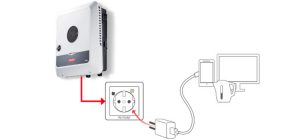The Brazilian DG (distributed generation) market has more than 677 thousand connected photovoltaic systems, of which more than 616 thousand are in the residential class, that is, small plants supplying people who decided to generate energy in their own home. The data are from ANEEL (National Electric Energy Agency).
There are several technologies and ways to build a photovoltaic system, but a common feature among these residential systems is the connection to the distribution network.
In other words, they all use photovoltaic inverters for on-grid application, where the great advantage is the generation of their own energy during the day and the use of the grid at night or in periods of low solar production.
However, what is the great asset of on-grid inverters is also their main weakness, as at times when the distribution network presents a failure or shutdown, necessarily and for obvious safety reasons, your on-grid inverter must be switched off. disconnect, thus stopping generating energy, at this moment the user is without the possibility of using their electrical equipment even if the sky is clear with plenty of sun.
Considering this reality, the main question customers ask is: “How can we not run out of energy with an on-grid system, in the event of a grid failure, and without needing a backup battery or generator?” With this type of situation in mind, Fronius presents the PV-Point function for the new inverters in the Primo GEN24 Plus range from 3 to 6kW.

The on-grid inverters of the GEN24 Plus line have all the technologies found in the other models of the well-known Fronius family of SnapINverters inverters, functions such as Dynamic Peak Manager for partial shading situations, active ventilation to increase the useful life and efficiency of the electronic components , integrated monitoring through Solar.Web, and the new PV-Point backup function.
What is the backup function?
A backup system or backup power is used when there is a drop in the standard power supply, which may be caused by a failure or interruption due to maintenance in the distribution network.
There are several ways to design a backup system, which may or may not include photovoltaic generation. In the case of a system with the GEN24 inverter, the backup function would already be included through PV-Point.
How does PV-Point work?
Next to the GEN24 Plus inverter connection terminals, there is a connector isolated from the AC network, where it is possible to supply an emergency system in the event of a network failure.
This connector will be automatically energized as soon as the inverter's anti-islanding system is activated, that is, as soon as there is disconnection from the distribution network.

This function has the capacity to keep a system of up to 3kW in operation, remembering that if the user does not have a battery attached to the GEN24, this power will depend on the photovoltaic generation.
However, thinking about emergency applications where the need is to power base loads such as electronics or lighting, this function is more than sufficient and corrects one of the main problems of the on-grid system, mentioned at the beginning of this text.
The table below shows the average power of some domestic electrical equipment, the complete material can be found through the source.

For example, currently the most modern and fastest Apple cell phone chargers have a power of 30W. In this sense, an intelligent way of using the PV-Point function is to provide the user with a socket point that will be energized in the event of a network failure, so that the user can connect whatever equipment is necessary at that moment.

The system setup is quite simple, carried out using the free application specific to Fronius inverters. It is a natural evolution of photovoltaic systems to add functions that bring convenience to the end user, not necessarily using storage systems that still have a high value on the market, but rather with simple technologies that will contribute to the good performance of the installation.















2 Responses
Hello, congratulations on the initiative to work on an improvement technology, very good.
But will this technology provide autonomy of up to how many hours after a utility blackout?
How long will this system keep the house and appliances working?
COOL, AND SUPER INTERESTING MATTER, WE CAN REALLY THIS WAY CREATE A SEPARATE NETWORK SYSTEM FOR THE CUSTOMER, I JUST COULDN'T UNDERSTAND IF THIS INVERTER HAS AN OUTPUT FOR A BATTERY BANK, IT WOULD BE INTERESTING WITH THE MATERIALS TO LEAVE THE DATASHEET OF THE EQUIPMENT POSTED AND THEIR FORECAST IN THE BRAZILIAN MARKET, OR IF THEY ARE ALREADY SOLD, IT WAS WORTH THE SOLAR CHANNEL'S PERFORMANCE IN ALWAYS BRINGING US NEWS.
ENG. LAURO DA SUBSOLAR, TOGETHER WE ARE STRONGER…